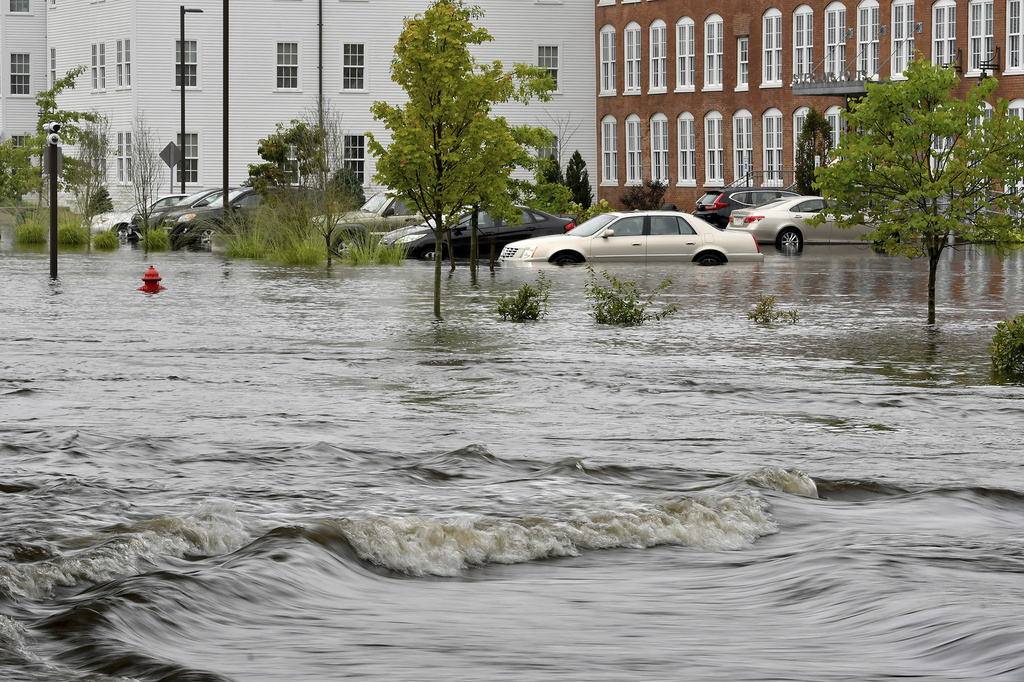More heavy rain was in the forecast Wednesday in New England, where residents kept one eye on cleanup and another on the path of Hurricane Lee after downpours dropped nearly 10 inches (25 centimeters) of rain in six hours and flooded parts of Massachusetts and Rhode Island.
The rainfall was a “200-year event,” said Matthew Belk, a meteorologist with the National Weather Service in Boston. Massachusetts Gov. Maura Healey issued a state of emergency Tuesday night following the “catastrophic flash flooding and property damage” in two counties and other communities.
The rain created sinkholes in Leominster, Massachusetts. Cars sank into the ground at an auto dealership. The front yard collapsed at one house, resulting in a 15-foot (4.6-meter) hole that exposed the foundation.
Andre Obin said his parents, who have lived in the home for many years, were able to pull out of their driveway shortly before the cave-in.
“We’re just so lucky that the pavement didn’t give out underneath the vehicle,” he told WCVB-TV.
Parts of Connecticut and Massachusetts were under a flash flood warning Wednesday morning, with radar indicating storms and an expected rainfall rate of 2 to 4 inches (5-10 centimeters) an hour, the National Weather Service said. Additional rainfall amounts of 2 to 4 inches are possible in some areas.
Rain from Hurricane Lee didn’t contribute to the flooding earlier this week. But it could inundate parts of the coastal Northeast during the weekend, forecasters said. Lee is traveling north and could make landfall in Nova Scotia, Canada, possibly as a tropical storm, forecasters said.
Up to 300 people were evacuated by Tuesday morning in Leominster, about 40 miles (64 kilometers) northwest of Boston, Mayor Dean Mazzarella said. He said the city has not seen such widespread damage since a 1936 hurricane. Most buildings downtown flooded and some collapsed. Rail service also was disrupted.
Leominster’s director of emergency management, Arthur Elbthal, said two dams out of 24 in the city sustained damage but held. He said the city is reinforcing them.
Belk said a trained spotter near Leominster recorded 9.5 inches (24 centimeters) of rain. The record for rainfall in a single day in Massachusetts was set Aug. 18, 1955, when Tropical Storm Diane dropped just over 18 inches (nearly 46 centimeters) in Westfield, Belk said.
Healey said she’s keeping a close eye on the forecast and how Hurricane Lee may affect the state as she toured flood damage in North Attleborough, about 55 miles (89 kilometers) south of Leominster.
“It was really scary, the amount of water that fell in just a short amount of time and the incredible devastation that it caused,” Healey said, adding she had reached out to the Biden administration, the state’s congressional delegation and the Federal Emergency Management Agency for assistance.
Dawn Packer, who runs a North Attleborough home preschool, looked across the street Monday evening to see a UPS truck floating in several feet of water. Soon her yard was flooding.
“We ran downstairs. It was dry. We were happy about that. I started putting all my child care center stuff up high. All of sudden, the door smashed open. The water was so forceful. It just smashed the door open and poured in, 4 feet,” she said. “The refrigerator just shot up into the air and fell down on its side. It was horrific.”
On Tuesday, a generator was rumbling in their backyard as Packer and her husband tallied their losses — as much as $30,000 to $40,000 to fix an electrical system and rebuild her business.
“It’s devastating to see,” Packer said, her voice breaking.
Nathan Bonneau’s North Attleborough home was condemned Tuesday after a building inspector assessed the flood damage. He said the water rose nearly to his height of 5 feet 10 inches (178 centimeters).
“It just kept getting worse,” he said. “I watched the water go from trickling into my garage floor to coming in my front door in a matter of 35 minutes.”
Early Tuesday, the city evacuated people who live near the Barrett Park Pond Dam as a precaution. The 15-foot-tall (4.5-meter-tall) earthen structure is listed in poor condition and posing a significant hazard, but would not be expected to cause loss of life, according to the U.S. Army Corps of Engineers’ National Inventory of Dams. The database shows it was last inspected in November 2017.
Some roads in Rhode Island and in Nashua, New Hampshire, were also inundated.
In Providence, Rhode Island, downpours flooded a parking lot and parts of a shopping mall. Firefighters used inflatable boats to rescue more than two dozen people stranded in cars.
New England has experienced its share of flooding this summer, including a storm that dumped up to two months of rain in two days in Vermont in July, resulting in two deaths.
Atmospheric scientists say floods in different parts of the world are fueled by climate change.
Mathew Barlow, a climate scientist at the University of Massachusetts-Lowell, said heat spurred by climate change means the air can hold more more water.
“As long as fossil fuel emissions continue, this will get worse,” he said. “So this won’t be a new normal. This will be a way station on the way to ever more intense systems unless we choose to dramatically decrease emissions.”
(AP)











